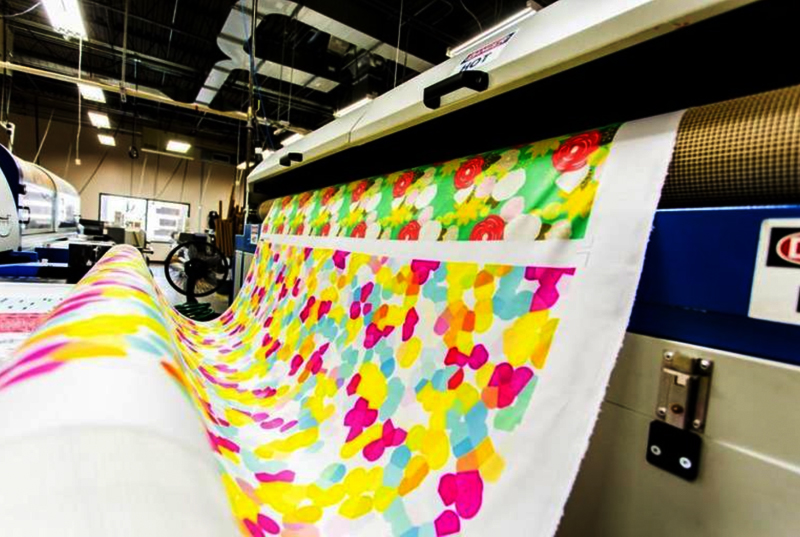Fabric is printed on a larger printer at Spoonflower in Durham which gives designers the freedom to turn their own designs into custom textiles. Israel Schwartzberg
Digital fabric printing is one of the hottest new trends in the fashion industry. And the Triangle is at the forefront of this trend with facilities such as N.C. State’s new digital textile printing lab and Durham’s Spoonflower, a company that produces custom fabrics through digital printing techniques.
The new printers offer an alternative to traditional screen printing, which can be a costly process.
Bringing custom printing to consumers
Durham fabric producer Spoonflower (spoonflower.com) utilizes similar digital printing technology to create custom textiles (along with wallpaper and gift wrap) for designers and pretty much anyone else who’d like to create their own fabrics. The company allows customers to upload digital images – anything from photographs to original sketches or paintings – choose their fabric type and have their design produced in the quantity they need, from a yard to hundreds of yards.
EASY-TO-USE, AFFORDABLE SERVICES LIKE SPOONFLOWER ALLOW BUDDING DESIGNERS TO PUT THEIR STAMP ON THE FABRIC ITSELF, AS WELL AS ON THE DESIGN OF THE GARMENTS THEY PRODUCE. THE GREAT BENEFIT OF ALL THAT IS THAT THE INDUSTRY BECOMES MORE DIVERSE, AND CONSUMERS HAVE MORE CHOICES ABOUT HOW THEY CHOOSE TO EXPRESS THEMSELVES THROUGH FASHION.
Stephen Fraser, co-founder of fabric producer Spoonflower
Stephen Fraser, who co-founded Spoonflower in 2008, says digital printing allows designers to take creative risks at a minimal cost, both moneywise and timewise.
“The biggest impact that digital printing has had for designers has been to allow an unprecedented amount of experimentation,” he says. “Before digital fabric printing services came along, creating a unique fabric was difficult and expensive. But because a digital process does not require any minimum order, designers are free to create and print as many designs as they like, with far fewer limitations in terms of color and design. This has the effect of expanding both the number of designs available, and also the pool of artists who are experimenting with fabric design as a medium.”
Technology equals speed
The speed factor also is another big advantage of digital fabric printing, particularly in the fashion industry. Trends change quickly, and being able to go from initial sketch to finished product in a short time makes a big difference.
“It’s important to be able to clearly communicate our end result and do it quickly,” says Hilder. “A consumer is used to fast fashion and quick turnarounds, so to be able to get it quickly is very important.”
That speed is even more critical in a time when Internet sales are increasing and product demand is higher than ever.
“What’s really changing our industry right now is Internet sales,” says Chapman. “In stores, they can pretty much predict the amount of goods they need to produce, but with online, it’s very hard to predict what they’ll need year to year. Trying to predict that is really going to be a challenge going forward, and everyone’s looking at technology as a way to respond to that.”
Designers in control
Digital textile printing also helps eliminate the middleman, so to speak, giving designers the ability to control the production process.
“One of the issues that’s always frustrating with designers is the design and production process are always very separated, and a lot of times the designer has to compromise their design, and concepts of their design are lost in the production process,” says Chapman. “With digital printing, the design and production are the same; the designer is creating the production, as well.”
“All the mishaps that can happen when you have cultural and language barriers when you design something in New York and you’re having it produced in Taiwan or Europe – there’s a lot that can be missed in translation. There’s also a lot of time involved when the designer sends their design over and then production produces a sample, and then there’s a lot of back and forth; with digital there’s none of that.”
A level playing field
But perhaps most of all, digital fabric printing has helped to level the playing field in fashion, making the industry more accessible for emerging designers who are trying to break into the business and get their clothing into the marketplace.
“Just as it has in music, video and other content forms, the digital revolution makes the world of design much more democratic,” says Fraser. “Easy-to-use, affordable services like Spoonflower allow budding designers to put their stamp on the fabric itself, as well as on the design of the garments they produce. The great benefit of all that is that the industry becomes more diverse, and consumers have more choices about how they choose to express themselves through fashion.”
http://www.newsobserver.com/living/fashion/article50039470.html



